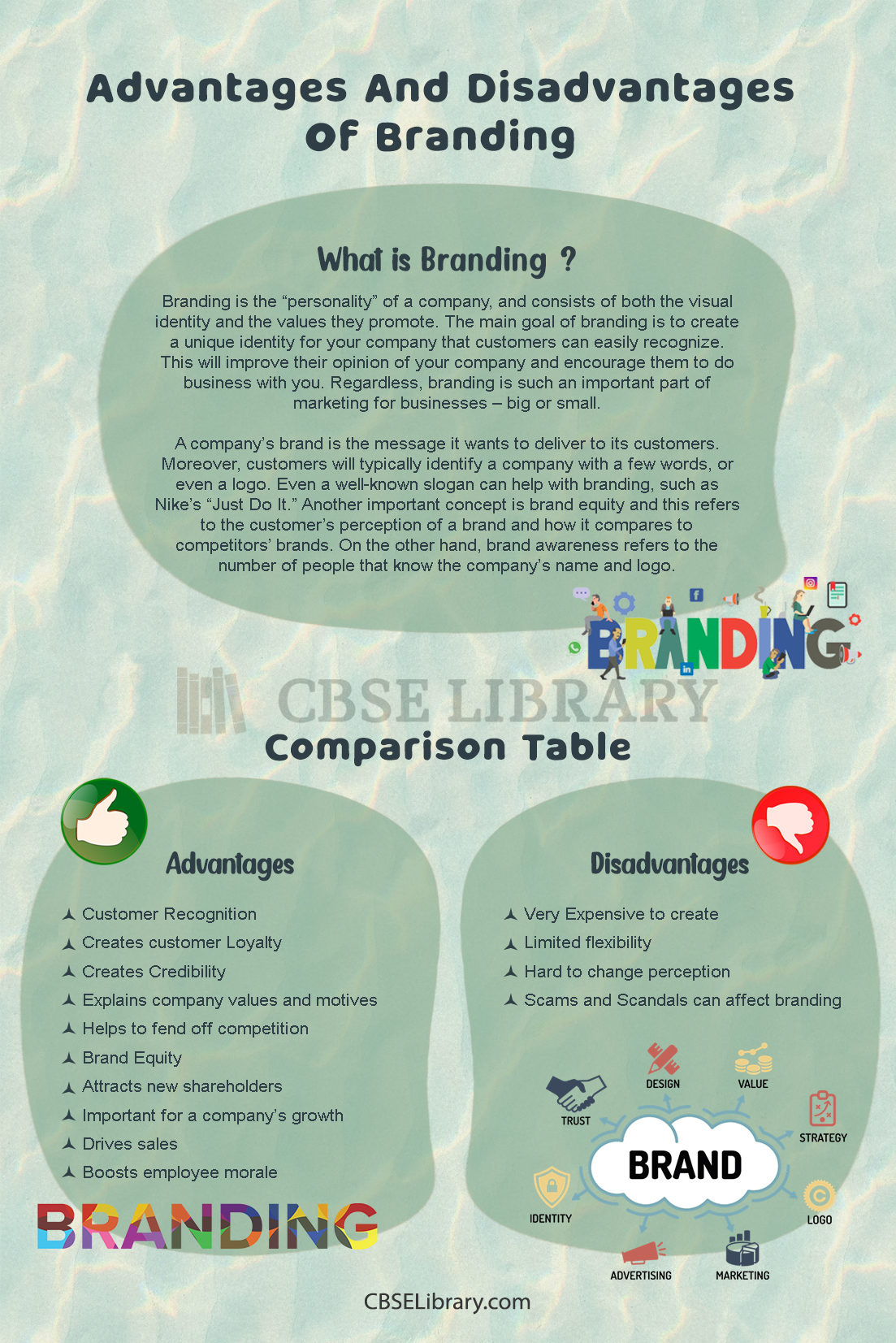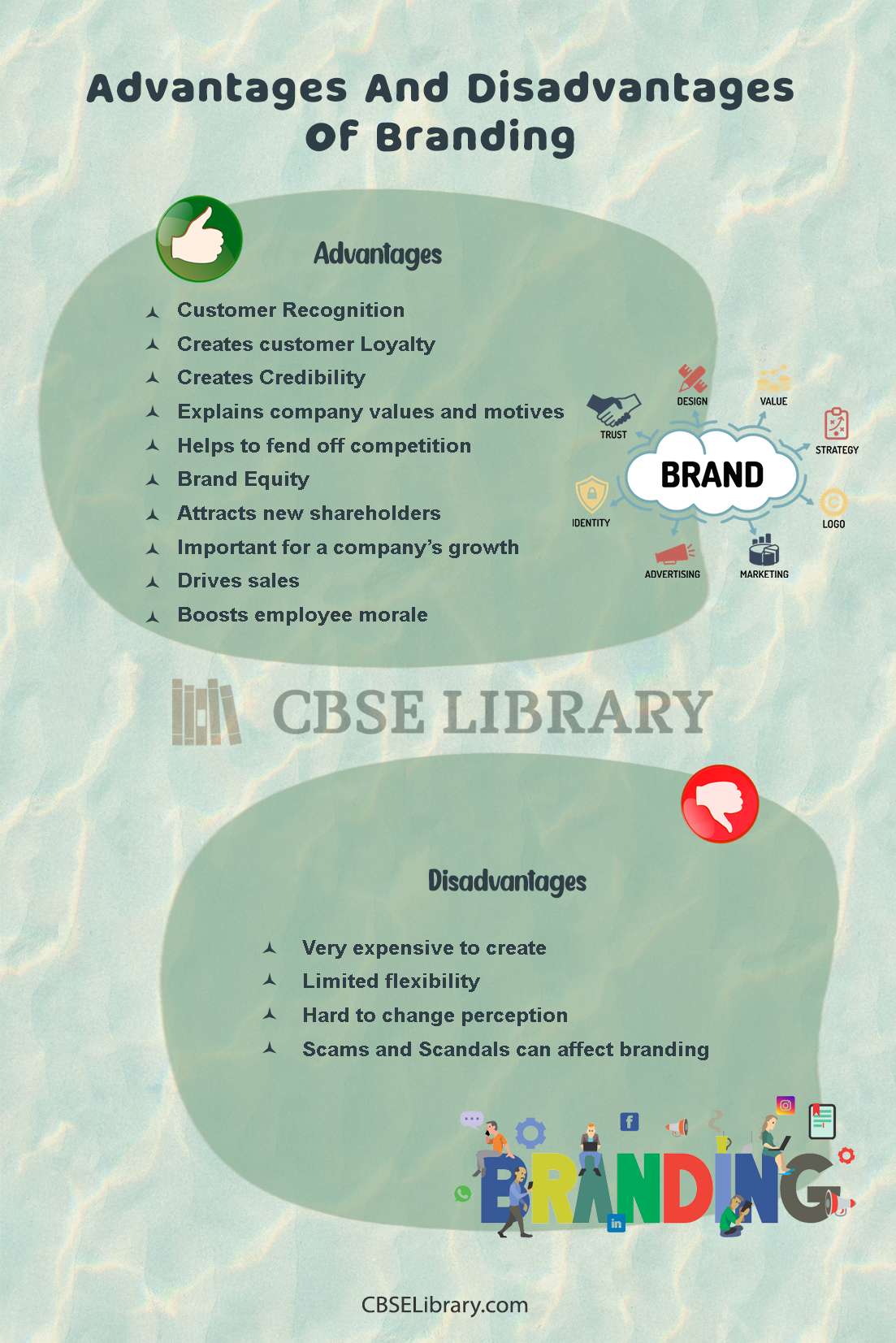Advantages And Disadvantages of Branding: Branding is the “personality” of a company, and consists of both the visual identity and the values they promote. The main goal of branding is to create a unique identity for your company that customers can easily recognize. This will improve their opinion of your company and encourage them to do business with you. Regardless, branding is such an important part of marketing for businesses – big or small.
A company’s brand is the message it wants to deliver to its customers. Moreover, customers will typically identify a company with a few words, or even a logo. Even a well-known slogan can help with branding, such as Nike’s “Just Do It.” Another important concept is brand equity and this refers to the customer’s perception of a brand and how it compares to competitors’ brands. On the other hand, brand awareness refers to the number of people that know the company’s name and logo.
Students can also find more Advantages and Disadvantages articles on events, persons, sports, technology, and many more.
- Advantages of Branding
- Disadvantages of Branding
- Comparison Table for Advantages and Disadvantages of Branding
- Conclusion on Branding – Advantages And Disadvantages
- FAQs on Advantages And Disadvantages of Branding
Advantages of Branding
There are many advantages to branding. When a company has a strong brand recognition, it is easier to market the company. A good brand will also help with customer retention. Branding can be used to signify quality or craftsmanship as well. Other benefits of branding are as follows:
- Customer Recognition – The goal of branding is to create a recognisable brand that people will remember, and return to. A popular example of this is the golden arches of McDonald’s. Whenever customers see the golden arches, they associate it with the company’s quality products. They’ll often return to McDonald’s when they’re looking for a quick meal or snack.
- Creates customer Loyalty – A strong brand creates customer loyalty. When a person becomes loyal to a particular product, it becomes a source of happiness and comfort. This is known as a brand’s “psychological value.” Unlike in the past when people bought products based on price, people today also consider quality. Brands are created through advertising campaigns to distinguish themselves from other brands and to develop a sense of trust among customers.
- Creates Credibility – A brand is a name, sign, symbol, or design that identifies the good or service of one seller from others. Branding amplifies the image of a certain product because it creates credibility by building trust. Consumers subconsciously believe that branded merchandise is of high quality and worth the price.
- Explains company values and motives – A brand is a representation of the company’s values and motives. It is important to have a cohesive image and identity for any product or service, so customers will know what the company stands for. Some brands use slogans to tell their customers who they are, other brands identify themselves with colours like Coca-Cola’s red colour or Nike’s white stripes.
- Helps to fend off competition – Branding is a very important part of the business world today. It is the most valuable asset that an organisation has, which means it needs to be protected. A brand can fend off competition by keeping them from targeting potential customers. Moreover, companies also become more memorable when their branding is recognizable.
- Brand Equity – Brands do not need to rely on advertising as much as they used to because they have built up a large amount of equity. Consumers are willing to buy from brands that they know and trust, even if their competitors have a cheaper product. This is because the consumer can depend on the brand’s quality and service. Consumers will also be more willing to pay higher prices for the products because of this equity.
- Attracts new shareholders – When a company is well known for its product or service, it attracts new shareholders. These investors are typically interested in the company because of its reputation. Large companies have been able to improve their public image by creating dedicated social media accounts that focus on corporate responsibility and transparency.
- Important for a company’s growth – Branding is an important component of a company’s growth strategy. It establishes a company’s identity and distinguishes it from the competition. Brands can also be used to position companies for a specific market niche. Brands help customers identify the value of a company’s products and services, and this can lead to increased sales and awareness.
- Drives sales – The main advantage of branding is that it drives sales and can make a company more competitive. If a company has a logo or slogan, their target audience will know what they stand for and be more likely to purchase their products or services. This is especially helpful for small businesses that would otherwise get overlooked in the competitive marketplace.
- Boosts employee morale – Branding is helpful in creating a positive atmosphere for employees. When morale is high, companies can experience great success in both their personal and business lives. Oftentimes, the employees are the backbone for a company’s success and branding helps to bring everyone together.
Disadvantages of Branding
Branding has many advantages, but there are also disadvantages of branding. Some companies have gone out of business because they overextended themselves and tried to appeal to the masses. Other downsides of branding are as follows:
- Very expensive to create – Branding is an absolute necessity in order to maintain a company or business. However, developing a good brand will cost anywhere from $200,000 to $2 million, which can be a huge expense depending on the size of your company. If a business doesn’t have enough capital to develop a good brand, they may end up having very few customers.
- Limited flexibility – When a company invests heavily in branding, it can be difficult to change it. There are often risks involved in modifying branding efforts, and even when a brand is redesigned, the new design may not have the desired effect.
- Hard to change perception – When branding is done correctly, it can be a great tool. The logo and slogan are usually the start of branding which allows consumers to identify with the company on a deep level. The problem is that once certain associations are made, they’re hard to change. For example, people still associate the Nike logo with sweatshops, even though the company has worked to change this perception in recent years.
- Scams and Scandals can affect branding – Another disadvantage of branding is that it can be difficult to change if you have a bad reputation. For example, when news broke that Volkswagen was cheating on emissions tests in 2016, the company’s brand value plunged. VW had to deal with recalls, lawsuits and fines that cost an estimated $46 billion.

Comparison Table for Advantages and Disadvantages of Branding
Following are the advantages and disadvantages of branding:
| Advantages | Disadvantages |
| Customer Recognition | Very Expensive to create |
| Creates customer Loyalty | Limited flexibility |
| Creates Credibility | Hard to change perception |
| Explains company values and motives | Scams and Scandals can affect branding |
| Helps to fend off competition | |
| Brand Equity | |
| Attracts new shareholders | |
| Important for a company’s growth | |
| Drives sales | |
| Boosts employee morale |
Conclusion on Branding – Advantages And Disadvantages
Branding is the process of developing a unique identity for your product or service. It includes logo design, colour matching, and typography that provides a unified look to other marketing materials. Once a company has created a branding strategy, the next step is to implement it with logos on products, signs in public places, colours in advertisements, and more.

FAQs on Advantages And Disadvantages of Branding
Question 1.
What is Branding?
Answer:
Branding is a process that helps a company create a recognisable name, symbol, or slogan for itself. It often involves putting the logo on the company’s products and marketing materials. Over time, the branding can make consumers more likely to buy products from that company because they trust its quality and reliability.
Question 2.
What are the advantages and disadvantages of branding?
Answer:
A Brand is a name, symbol, or trait that represents a specific company or product. Branding is the process of designing and managing the perception of a brand. It’s very important for businesses because it shapes customer perceptions about the company. It builds customer loyalty by creating a sense of familiarity with their products. A disadvantage of branding is that it can be expensive to change an image if it doesn’t work well for customers.
Question 3.
Why is branding important?
Answer:
A brand is one of the most valuable assets that a company has. A good brand image will create an emotional connection with customers and make them feel like a product or service is the best. There are two types of “branding” that companies use to establish themselves. These are called “inbound branding” and “outbound branding.” Outbound branding includes advertising, which includes things like radio, billboards, TV commercials, and print ads. Inbound branding includes things like social media networks and customer reviews.